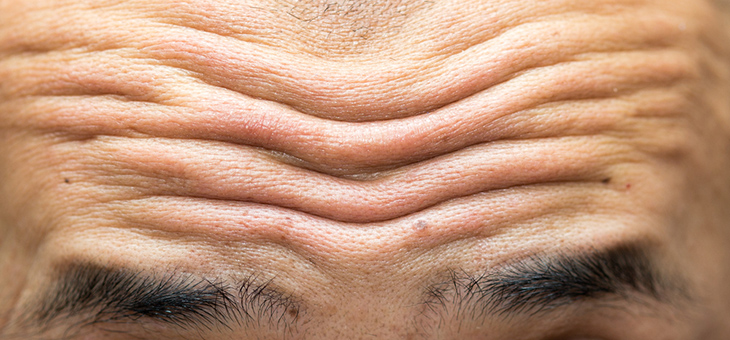Are wrinkles just an inevitable consequence of ageing, or could they signal something more sinister?
According to research presented to the European Society of Cardiology this week, people who have lots of deep forehead wrinkles, more than is typical for their age, may have a higher risk of dying of cardiovascular disease (CVD).
Assessing brow wrinkles could be an easy, low-cost way to identify people in a high-risk category for CVD.
“You can’t see or feel risk factors like high cholesterol or hypertension,” says study author Dr Yolande Esquirol. “We explored forehead wrinkles as a marker because it’s so simple and visual. Just looking at a person’s face could sound an alarm, then we could give advice to lower risk.”
That advice could include straightforward lifestyle changes like getting more exercise or eating healthier food.
“Of course, if you have a person with a potential cardiovascular risk, you have to check classical risk factors like blood pressure as well as lipid and blood glucose levels, but you could already share some recommendations on lifestyle factors,” Dr Esquirol points out.
Risk of heart disease increases as people age, but lifestyle and medical interventions can mitigate the danger. The challenge is in identifying high-risk patients early enough to make a difference.
According to the study authors, previous research has analysed different visible signs of ageing to see if they can predict cardiovascular disease.
In prior studies, crow’s feet showed no relationship with cardiovascular risk but these tiny wrinkles near the eyes are a consequence not just of age but also of facial movement.
A link has been detected between male-pattern baldness, earlobe creases, xanthelasma (pockets of cholesterol under the skin) and a higher risk of heart disease, but not with an increased risk of actually dying.
The authors of the current prospective study investigated a different visible marker of age – horizontal forehead wrinkles – to see if they had any value in assessing cardiovascular risk in a group of 3200 working adults.
Participants, who were all healthy and were aged 32, 42, 52 and 62 at the beginning of the study, were examined by physicians who assigned scores depending on the number and depth of wrinkles on their foreheads. A score of zero meant no wrinkles while a score of three meant ‘numerous deep wrinkles’.
The study participants were followed for 20 years, during which time 233 died of various causes. Of these, 15.2 per cent had score two and three wrinkles, 6.6 per cent had score one wrinkles and 2.1 per cent had no wrinkles.
The authors found that people with a wrinkle score of one had a slightly higher risk of dying of cardiovascular disease than people with no wrinkles. Those who had wrinkle scores of two and three had almost 10 times the risk of dying compared with people who had wrinkle scores of zero, after adjustments for age, gender, education, smoking status, blood pressure, heart rate, diabetes and lipid levels.
“The higher your wrinkle score, the more your cardiovascular mortality risk increases,” explains Dr Esquirol.
Furrows in your brow are not a better method of evaluating cardiovascular risk than existing methods, such as blood pressure and lipid profiles, but they could raise a red flag earlier at a simple glance.
Do you have deep forehead wrinkles? Are you more likely to have your heart health tested now?
Related articles:
Tips for coping with ‘sundowning’
Your nose can sniff out bad health
What’s not covered by Medicare?

